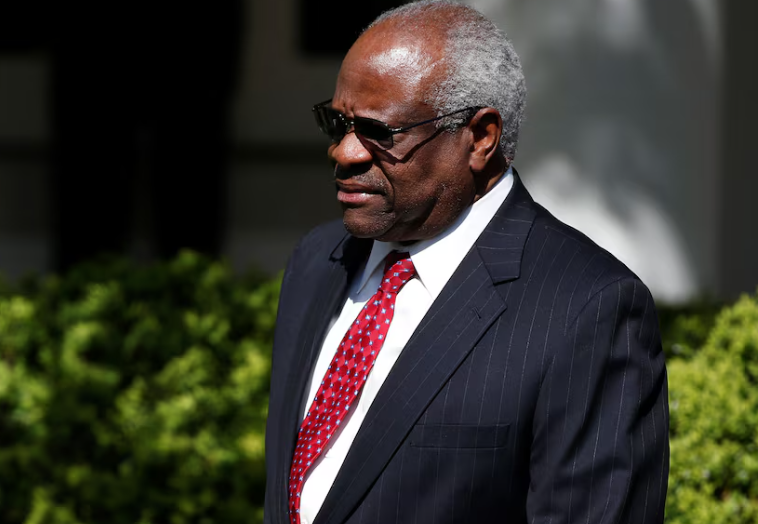Supreme Court Justice Clarence Thomas has adopted a legal theory that would eliminate numerous recent lawsuits filed by groups opposing race-based diversity programs, which align with his conservative views. In a concurring opinion in last week’s Supreme Court decision preserving access to the abortion pill mifepristone, Thomas questioned the constitutional foundation of a legal doctrine that permits groups to file lawsuits on behalf of their members.
Thomas acknowledged Supreme Court precedent explicitly endorsing the right of organizations to sue on behalf of members allegedly harmed by a law or policy. As my colleague Nate Raymond reported on Thursday, that case law dates back to a 1958 Supreme Court decision that allowed the NAACP to sue Alabama for demanding disclosure of NAACP members’ names and addresses. The justices later cemented the doctrine, known as associational standing, in a 1977 ruling that allowed a Washington State agricultural agency to challenge a North Carolina apple-shipping regulation on behalf of the agency’s members.
In his new concurrence, Thomas argued that the Supreme Court has never explained how such cases satisfy the constitutional requirement that plaintiffs must allege a concrete injury addressable by litigation. “Associational standing,” he wrote, “seems to run roughshod over this traditional understanding of the judicial power.” Thomas particularly criticized cases in which groups sue on behalf of a few members to block policies, laws, or regulations. He asserted that the U.S. Constitution does not permit plaintiffs to seek remedies beyond their own injuries, and organizations without their own injury should not demand widespread prohibitions in the name of some supposedly injured members.
This theory directly challenges the actions of some conservative groups following last year’s Supreme Court decision barring colleges and universities from considering race in admissions policies. Groups like America First Legal, the American Alliance for Equal Rights, and Do No Harm have filed numerous lawsuits challenging business programs that boost racial and ethnic diversity. These groups typically claim that because one or more of their members was illegally excluded from the challenged program, the doctrine of associational standing entitles them to sue on behalf of their allegedly injured members.
Lower courts have split on how much detail these groups must provide about members claiming harm from corporate diversity initiatives to meet constitutional standing requirements. The 2nd U.S. Circuit Court of Appeals ruled in March that organizations seeking to enjoin diversity programs must disclose the real name of at least one injured member. Conversely, the 11th Circuit held earlier this month that the American Alliance for Equal Rights met constitutional standing requirements by offering nearly identical declarations from three unnamed members who alleged illegal exclusion from a grant program for Black women.
According to Thomas’s reasoning on associational standing, lower courts need not tinker with the precise parameters of required disclosures about groups’ injured members. In his opinion on the abortion pill case, Thomas argued that these groups do not have a constitutional right to bring lawsuits to shut down diversity programs. Do No Harm, America First Legal, and the American Alliance did not immediately respond to requests for comment. However, Edward Blum, president of the American Alliance and an anti-affirmative action activist, said he “has no opinion” on Thomas’s new theory.
Thomas has long been a maverick on constitutional standing but had never before expressed skepticism about the entire concept of associational standing. He did not question the right to sue for the Blum-founded group that won last year’s Supreme Court rulings against affirmative action policies at Harvard and the University of North Carolina.
In the abortion pill case, Thomas cited an amicus brief from Andrew Hessick, a law professor at the University of North Carolina, who co-authored a forthcoming University of Chicago Law Review article calling for the Supreme Court to abandon the doctrine of associational standing. Thomas, swayed by Hessick’s arguments, cited the professor’s brief twice in his new concurrence.
In an interview, Hessick noted that Thomas, whose opinion was not joined by any other justices, remains the only Supreme Court member to adopt skepticism about associational standing. However, he predicted that Thomas’s opinion will spark debate in the lower courts. “At the very least, talking about this is very important,” Hessick said. He argued that courts should be particularly wary of associational standing for groups created specifically to bring lawsuits. His amicus brief in the affirmative action case argued that the doctrine erodes the foundational principle of separation of powers by allowing ideologically opposed individuals, who are not directly affected by a law or policy, to “manufacture standing out of thin air” by founding a group and recruiting like-minded members to claim injury.
Both Hessick and Thomas stated that class actions, where a representative plaintiff sues on behalf of similarly situated people, can achieve the same goals as associational lawsuits while avoiding constitutional concerns through procedural rules ensuring class members were injured. Hessick suggested that people fearing reprisal can vindicate their rights through class actions and pseudonymous lawsuits without relying on a group to sue on their behalf.
As circuit courts debate standing in diversity challenges by conservative groups, it remains to be seen if Thomas’s adoption of Hessick’s argument will gain traction.

